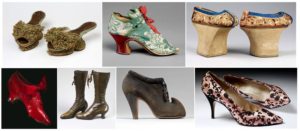 The high-heeled shoe has been around for longer than you might think. There is evidence that depicts both the Egyptians and Romans wearing heels for various practical reasons. Nor were they restricted to one gender; both upper-class men and women wore them. The high heel remained a practical piece of clothing in the middle ages as they kept you out of the mud when walking. Fast forward slightly, and we see men wearing heels to emphasis their class, privilege, and power within society before the high heel became a feminine icon from the 1500s onwards.
The high-heeled shoe has been around for longer than you might think. There is evidence that depicts both the Egyptians and Romans wearing heels for various practical reasons. Nor were they restricted to one gender; both upper-class men and women wore them. The high heel remained a practical piece of clothing in the middle ages as they kept you out of the mud when walking. Fast forward slightly, and we see men wearing heels to emphasis their class, privilege, and power within society before the high heel became a feminine icon from the 1500s onwards.
Women started wearing high heels for much the same reasons as men had done. Royal figures, such as Catherine de Medici and Mary I of England, wanted shoes that made them look taller and give an alluring sway when walking. These high shoes then allowed women to wear longer dresses. It was the length of your dress in this period of history that signalled how wealthy you were. The longer the dress, the more expensive fabric you had to use. Women wore shoes called ‘chopines’ that could be eight to thirty inches high and required women to use canes or even servants to help them to walk. Catherine de Medici later turned the high heel shoe into something more fashionable, rather than functional, making heels thinner and more stylised. Nothing would change until 1793 when Marie Antoinette was executed wearing two-inch heels. For the next seventy years, flat shoes ruled, and heels were reduced to a mere wedge.
The invention of the sewing machine in the 1860s would revive the high-heeled shoe. There came more variety and a change in attitudes towards the shoe. The Victorians believed that the heel emphasised the curved figure of a woman and the upper-class status of the high heel returned. To wear high heels was a clear sign that the wearer did not engage in manual labour. This ideal stayed well into the 1950s when the identifiable symbols linked with high heels changed once more. They now played “an important part in what different cultures consider to be sexy”. Thanks to new technology the stiletto appears at this moment in history. The high heel becomes more stable and a metal “shank” running through the shoe is introduced. The 1960s, therefore, brought sex appeal to the high heel. Femininity became strongly represented with heels and many women felt that wearing heels indicated subservience to men and submitted to sexual stereotyping.
Today, shoes are mass-produced, and this has left the social connotations of status way behind. We have come to focus more on the design and style of the shoe, just as Catherine de Medici did all those centuries ago. Designing shoes is an art form in our modern world and designers work hard to bring about new innovative styles and fashions for high street outlets, or the catwalk. Shoes of all kinds have become collectables simply because of their unique design and have become something to be admired as a result. It is perhaps true, then, that high heels are objects of desire. There are many who do not acquire shoes simply for their financial value. “Shoes are collected for the pleasure of possessing, because of the beauty of shoes and sometimes for the memories and associations that do with them”.
It may just be me, but high heels seem to symbolize something more these days, even if some of the old connotations from the 1950s still remain. The high heel can make women feel stronger in a world continuously dominated by men. Perhaps it is because we can openly admire high heels without judgements on ourselves that we love them. When wearing high heels we simply feel different and ready to take on the world!
To discover more about the history of the high heel click the link above, check out CBS’s piece on high heels, or Random History’s “Dangerous Elegance: A History of High-Heeled Shoes“.
-Claire Amundson
Junior Girl
Girl Museum Inc.
